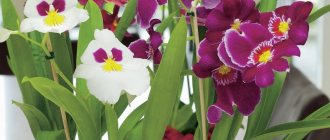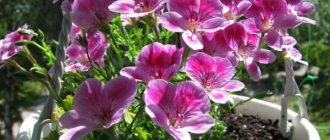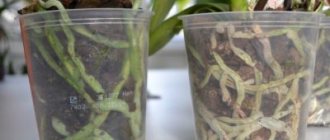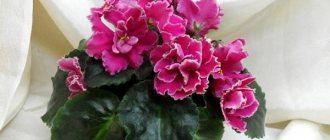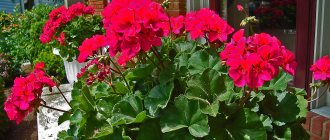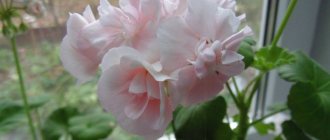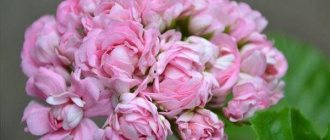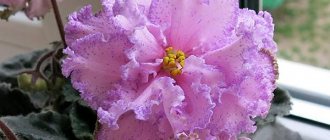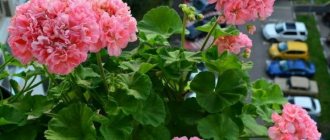Where and how to plant it?
Lighting and location
If a gardener wants his pet to please the eye with its flowering for a long period, it is necessary to place the pot with the plant in a well-lit place.
The flower does not like shadow. A window sill with windows facing south or southeast is perfect. But, it should be remembered that on too hot days, when the scorching rays of the sun penetrate the atmosphere, pelargonium should be shaded. This can be done using a piece of fabric or translucent paper. Decorative flowering cannot be achieved if there is not enough sunlight.
Important! When Clara feels a lack of lighting, the color of its leaves fades, and the plant itself loses its decorative appearance. In addition, the stems stretch, which also affects the beauty
In winter, you need to take care of additional light. You can use a special lamp.
Soil requirements
The flower has no special requirements for soil. More important than the soil is the drainage layer. There must be a layer of expanded clay at the bottom of the pot. Pelargonium has a negative attitude towards waterlogging. The delicate root system can easily rot in such conditions. The optimal soil for Clara Sun is neutral or slightly acidic. It is recommended to add ash to acidic soil.
Substrate composition:
- 1 part leaf soil;
- 1 part sand;
- peat and turf also 1 part each.
If the soil is not particularly nutritious, humus is added to it. In flower shops you can purchase ready-made soil, which is designed specifically for pelargonium.
This is interesting: When to transplant hydrangea from one place to another: we tell you in detail
Lighting and location
The flower belongs to the category of light-loving , but it is better not to place it in direct sunlight. In this case, the flower may overheat, which will affect the health and appearance of the leaves.
It would be optimal to place the flower close to the light source, but at the same time avoiding direct and scorching sunlight. If there is not enough light, you need to turn the plant over and expose its leaves to the light. If there is a lack of consecration, the leaves may dry out and fall off.
Varietal pelargoniums photo
Pelargonium sutarves klara san
Without registration using:
- ads
- Animals, plants Animals, plants
- Lost and found
- Business offers
- Childen's goods
- House, construction, renovation
- Beauty, health
- Furniture
- Education
- Clothes, shoes
- Part time job
- Holidays, weddings
- Sports, tourism, hobbies
- Help Wanted
- Services
- Electronics and household appliances
Plants, flowers
- Plants, flowers
Aquariums Accessories Rodents Other animals Food and supplements Kittens and cats Other Birds Beekeeping Fish, aquarium animals Farm animals Dogs and puppies Animal services Ferrets
Varietal pelargoniums
I will sell cuttings of varietal pelargoniums (availability as of October 6, 2020): April Snow 250 Boniface Butterfly 250 Botans Röda 300 Brookside Fiesta 250 Brookside Katerina 350 Deacon Constancy 200 Edwards Jouce 250 Elnaryds Gusten 400 Flaming Kate 250 Free Cerise Polina 300 Gos Brook Ryan David 300 Grainger's Antique Rose 500 Julie 250 Midori Buke (adult) Mimi 250 Mormor Marta 350 Natalie 250 Norrand red sport 300 Norranges Sophie 300 Odensjo Madam Bovary 300 Odensjo Milk and Honey 300 Orion 300 PAC Viva Carolina 300 Royal Norfolk 300 Rushmoor Amur 1000 Rushmoor Platinum An niversary 250 Saxdalence Selma 300 Selma 250 Vina 250 (adult) IV-Pavstushka 400 IV-Sonya Tender 400 IRIOL-Shimmer 400 Leona Drops 500 Silk Alchemist 500 Silk Laguna 300 Yu_Jiga 300 Yu_Kathak 400 Yu_Pink Snow (cactus type) 800 Yu_Snoa 300 Yu_Tsy ganochka 500 Yug-Eva 500
Potted bushes: Malins Parla 100 Millfield Gem 150
Flowering and dormant periods
With proper care, terry geranium blooms from February to September. During this period, all the inflorescences manage to replace each other in turn.
Terry pelargonium does not have a pronounced dormant period. In winter, the plant does not shed its leaves, but rarely blooms. During this period, it is necessary to reduce watering and abandon fertilizing. It is also advisable to reduce the temperature to +20 °C. It is better to place the flower pot on the windowsill - this way the coolness from the glass will be enough for a comfortable winter life.
Geranium is not only a beautiful, but also a useful plant. It releases bactericidal substances that kill germs. Medicinal infusions and decoctions are prepared from the leaves and roots of the flower.
We grow beautiful things with our own hands! Pelargonium Denise: photos and care features
Emma fran bengtsbo pelargonium
As mentioned above, Denise pelargonium is one of the most beloved plants by gardeners. Some of them call this variety Denis. On thematic forums there are literally queues for cuttings of this flower: flower growers are ready to shell out considerable sums for the shoot.
The plant belongs to the zonal rosebud varieties, therefore it has all the advantages of pelargoniums similar to roses. Among all rosebud pelargoniums, Denise is considered the most spectacular and most perfect flower.
The plant is not tall, unlike other rosebud species, but the bush still needs to be formed
Note that pruning in this case must be carried out carefully, since Denise is not very fond of this procedure. Who is the creator of this variety is still not known for certain
In addition, sellers of cuttings often sell other rosebud varieties for Denise, only externally similar to this variety. Therefore, it is best to purchase a plant from a nursery - this way there is less chance of running into a “fake” Denise
Who is the creator of this variety is still unknown for certain. In addition, sellers of cuttings often sell other rosebud varieties for Denise, only externally similar to this variety. Therefore, it is best to purchase a plant from a nursery - this way there is less chance of running into a “fake” Denise.
Plant propagation
Denis pelargonium reproduces in the same way as all its “neighbors” pelargonium: by seed and cuttings. When planting seeds, there is no guarantee that the plant will inherit all the characteristics and characteristics of the variety.
For this reason, rosebud pelargoniums are propagated exclusively by cuttings. Beginning flower growers often complain about rotting of planted cuttings. It is very disappointing when, with such difficulty, a cutting of your cherished dream - the beautiful Denizka - is acquired, but the efforts made do not bring the desired results, and the plant does not take root.
To avoid such disappointment, you can use the following recommendations:
- The optimal time for plant rooting occurs in March and lasts until July.
- Cuttings are taken from an adult plant. To do this, a cutting with 3-5 pairs of leaves is cut from a semi-lignified shoot. If you take a green grassy shoot, you won’t get a full-fledged cutting from it.
- The soil mixture for germinating a plant should be light and breathable, for example, peat + soil soil or coconut filler, the main thing is that the soil is neutral in acidity.
- The cuttings are dried on paper in the open air for one to two hours, the lower leaves are removed and planted in the ground, slightly buried in the ground.
- The planted cuttings are carefully watered, trying not to create excessive humidity.
- Water for irrigation is pre-settled for several hours at room temperature.
- Place the container with cuttings for rooting in a bright, well-lit room, for example, on a windowsill. In approximately half a month, the cuttings will acquire their first thin roots.
- As the flower grows, it is periodically fed with potassium-phosphorus complex fertilizers.
- In winter, the plant loses its decorative effect a little and practically does not bloom. Therefore, it is best to leave the rosebud dormant until spring, rarely water it and not apply any fertilizer. The recommended winter temperature for Denizok is only +10-15 degrees.
On a note. At the end of February, the pelargonium plant is moved to a warmer room, fed, and soon the bush begins to actively develop and by mid-summer pleases with its first buds.
Watering and spraying
The plant does not need spraying. The watering regime should be such that the substrate is constantly moist, but without stagnation of liquid in the roots. Watering is needed frequently and not abundantly.
Varieties of zonal pelargonium
Zonal pelargonium is classified depending on the number of petals, as well as the shape and structure of the inflorescences. In the first case, there are three generally accepted varieties:
- Non-double - 5 petals arranged in one row;
- Semi-double - the bud is formed by 6-8 petals;
- Terry - more than 8 petals are arranged in several rows, forming a dense flower.
The shape and structural features of the inflorescences make it possible to divide zonal geraniums into several types:
- Rosaceae (Rosebud) – double flowers form miniature roses when fully opened;
The height of the bush is another sign of the classification of zonal pelargoniums. Several varieties are known:
- Miniature – 10-13 cm;
- Dwarf - short, 13-20 cm;
- Medium (normal) – 30-60 cm;
- Tall (Irene) - up to 80 cm.
The color of the leaves of the zonal group can also vary, which made it possible to distinguish the following several species based on this characteristic:
- Conventional - the main tone of the leaf plate and the zone of a lighter or darker shade differ;
- Variegated - the color can be two-tone or three-tone with a predominance of golden, bronze, reddish tones, with the presence of spots or streaks;
- Butterfly leaves - in the center of the leaf there is a clearly defined zone in the shape of a butterfly in a contrasting shade.
As for the color of the inflorescences, zonal pelargoniums amaze with their diversity, presenting various variations of white, pink, salmon, coral, crimson, scarlet and red. One shade predominates, two or more shades transform into each other - it all depends on the varietal characteristics.
Zonal geraniums are divided into two special groups based on their rare flower color:
- Bird Eggs (“bird eggs”) – a characteristic speck is located at the base of each petal;
Pelargonium zonalis Bird Eggs
- Speckled - dots are located throughout the petal, there are also strokes and stripes.
Pelargonium zonal speckled
The indicated characteristics can be combined with each other, which leads to an exceptional diversity of varieties of zonal pelargonium. Every gardener will be able to find a specimen to their liking for growing indoors or outdoors.
Landing
Pelargonium ingrid
Let's find out the requirements of this plant for its habitat, soil, and lighting.
Location and lighting
In order for Pelargonium Clara to delight you with its flowering for a long time, you need to place its pot in a bright place. Like all geraniums, this plant does not like shade. If Clara does not have enough light, decorative flowering will not work: there will be few inflorescences, and those that appear will not be large in size.
If this measure is not taken into account, the flowering period will decrease, and the buds themselves will become much less lush and decorative. In addition, with a lack of light, Clara’s stems stretch and the foliage turns pale. This also negatively affects the beauty of the plant.
The soil
As for the composition of the soil, in this regard Pelargonium Clara is not particularly demanding.
Much more important for the plant is good drainage. Don't forget to put a layer of expanded clay on the bottom of the pot. Geranium does not tolerate waterlogged soil. Its delicate roots can easily rot in such conditions. Pelargonium Clara Sun will feel best in soil with either a neutral or slightly acidic reaction.
Experienced gardeners add ash to the soil if it is too acidic. Recommended substrate composition:
- leaf soil - 1 part;
- turf - 1 part;
- peat - 1 part;
- sand - 1 part.
If the soil is not very nutritious, you can also add humus. You can buy a ready-made substrate for geraniums in the store - in this case it will be optimal.
Let's get acquainted with the main points for caring for this ornamental plant.
Watering
Regular soil moisture is very important for Clara pelargonium. Although watering should be quite abundant, it is also important to avoid waterlogging the soil. Otherwise, the roots of the plant may begin to rot.
Therefore, water only when the top layer of the substrate dries out.
Otherwise, the roots of the plant may begin to rot. Therefore, water only when the top layer of the substrate dries.
If there is a need to humidify the air, then this must be done using a spray bottle, directing the stream to the area around the pot, and not to the plant itself.
Feeding
The plant needs additional nutrition. Clara responds to proper application of the necessary fertilizers with longer and more luxuriant flowering. In spring, the plant needs nitrogen compounds, and when the inflorescences begin to form, it is better to focus on potassium-phosphorus complexes. In the store you can purchase a complex mineral composition for pelargoniums. It will fit optimally in this case.
It is important to know that pelargonium does not like organic fertilizing. It is also important not to exceed the dose of fertilizer prescribed in the instructions. If you overuse fertilizing, the roots of pelargonium may well get a chemical burn.
The frequency of fertilizing during the growing season is twice a month; in winter, the plant does not need additional nutrition.
If you overuse fertilizing, the roots of pelargonium may well get a chemical burn. The frequency of fertilizing during the growing season is twice a month; in winter, the plant does not need additional nutrition.
Trimming
Only competent and timely pruning can give the pelargonium bush the correct compact shape and protect the plant from elongated, ugly shoots. Let us note that it was the inability to properly trim a flower that at one time was the reason for the loss of popularity among pelargoniums among flower growers. To form a compact and lush bush, you need to regularly pinch the apical parts of young shoots. This measure will allow the plant to grow wider and form a larger number of flower stalks.
As a rule, shoots of young plants are pinched after four to five pairs of leaves appear on them. The most suitable time for pruning is the spring months. And if pinching is used for young shoots, then pruning is used for adult plants.
The plant requires special attention in the first year of its life. During this period, it is necessary to spend the maximum amount of effort to form the correct shape of the bush. But in the second and subsequent years you can relax: the formed bush will require only “cosmetic” pruning.
Features of growing zonal pelargoniums
The southern temperament of zonal pelargonium affected its preferences in agricultural technology - to obtain a harmonious and abundantly flowering bush, you need good lighting and warmth, a nutritious, but at the same time loose, permeable substrate.
Thus, growing zonal pelargoniums comes down to several points:
- Lighting . It is preferable to have well-lit window sills that are exposed to the sun for several hours a day. On the south side, it is advisable to shade the pots so that the leaves do not suffer from burns; it is better not to grow them on northern windows;
- Watering . It is necessary to moisten the soil constantly, as the top layer of the substrate dries, but always in moderation. The earthen lump should neither dry out nor become waterlogged;
- Trimming . To obtain a compact bush with a harmonious crown, pelargonium must be pruned. Strong shortening of shoots is carried out at the end of February, sanitary pruning is carried out as necessary. Pinching the apical and lateral cuttings is also required;
- Feeding . During the period of bud formation and flowering, zonal pelargoniums must be fed using fertilizers for Geraniums.
Further care
Sutarve Clara Sun is unpretentious, but it is still necessary to follow the basic rules for caring for flowers so that they please gardeners with their appearance and long flowering.
To prevent the plant from stretching out, it is provided with an optimal light regime and shaded. To form a crown, a beautiful, even shape of the bush, periodically turn the pot. This way the branches and leaves are stretched evenly.
Water, observing the temperature regime. Feed and prune in a timely manner. If you follow the rules of care, Sutarve Clara San will constantly bloom and have a well-groomed appearance.
Temperature
Flowers should grow in a warm place. Comfortable temperature is from +14 to +27 °C in summer. This variety of pelargonium loves fresh air (not drafts), so the room is periodically ventilated. If the air in the apartment is dry, the tips of the leaves of the bushes dry out.
The plant does not tolerate temperatures below +12 °C - its growth and development slows down. Later it dies from hypothermia.
Watering and spraying
Pelargonium Sutarve Clara Sun is properly watered and sprayed if necessary. The plant does not tolerate either drying out or excessive moisture. Watering is carried out as the top layer of soil in the pot dries. If the earthen ball is constantly wet, then the roots of the flower begin to rot. In time he will die. Pelargoniums Sutarve Clara San can accumulate moisture and go without water for some time. Watering frequency is once every 1-3 days, less often in winter.
To prevent the leaves of the bush from drying out, spray them with a spray bottle with a fine spray nozzle. During the procedure, make sure that excess water does not collect in the rosettes of leaves - this harms the plant. In winter, spraying is not required. Sutarve Clara San, under optimal external conditions, does not require abundant watering and spraying.
Loosening
Sutarve Clara San grows normally in aerated soil, so it is periodically loosened in pots. If you do this after every watering, it will save you from fungal diseases.
Loosening is carried out carefully, penetrating the tool shallowly, without damaging the root system of Pelargonium Sutarve Clara San
Feeding
For abundant flowering, fertilizing is carried out regularly. Do not fertilize bushes only in winter, when they rest. For feeding, ready-made liquid fertilizers and universal compositions for flowers are used. It is better not to saturate Sutarve Clara Sun with organic fertilizers.
| Month | What to do |
| January | No fertilizing is carried out, the plant is resting |
| February | |
| March | Fertilize with fertilizer with a high phosphorus content |
| April | |
| May | Apply fertilizers with a high potassium content |
| June | |
| July | |
| August | |
| September | |
| October | |
| September | Fertilize with fertilizer with a high phosphorus content |
| December | No fertilizing is carried out, the plant is resting |
For continuous year-round flowering of indoor Sutarve Clara San, they are fed with magnesium sulfate. After applying fertilizer, the plant intensively grows buds and constantly blooms. Magnesium sulfate is stirred at the rate of 5 g per 5 liters of warm water. Water carefully, under the root.
Trimming
Constant pruning stimulates crown growth. It is not advisable to do this with scissors, because this will damage the flower branches. Cut the shoot at an acute angle using a utility knife or blade. The cut area is sprinkled with a powdered activated carbon tablet. Pruning is carried out at the end of February.
The tops and excess young shoots are carefully pinched without damaging the stem.
Features of reproduction
A flower can reproduce in several ways:
- Seminal. We plant the seeds in a pot with a drainage system and a height of 25 centimeters. We water them and stretch a film over the pot, which will create a greenhouse effect. After about two weeks, the first shoots will appear. As soon as they appear, you need to open the film every day to ventilate the small greenhouse. When the first two leaves appear, you need to pick.
- Cuttings. We cut off a young shoot from the plant. It must be placed in a glass of water and left for a couple of days. Then it can be planted in a pot with properly selected soil.
Numerous species and varieties of pelargonium differ not only in the color and shape of the inflorescences, but also in the configuration and color of the leaves. Among them the most famous are: Lady Gertrude, Andrea, Mildfield Rose, Richard Hudson, Norland, Salmon, Anita, Prince Gustav, Stellar and Clara Sun.
Zonartik is a fairly unpretentious plant that will regularly delight you with flowering if you organize proper care and pay close attention to the flower. Carefully selected soil, organization of watering and blessing, as well as regular fertilization of the soil is all that is required for a healthy and flowering plant.
Description of pelargonium Sutarves Klara San (Sutarve Clara San) and care for it
A stunningly beautiful plant with soft pink lush flowers, pelargonium Sutarve Clara San, is often grown in summer cottages, in rockeries, next to alpine hills. An unpretentious plant to care for, it belongs to the group of zonal pelargoniums.
Description of the variety
Pelargonium Sutarves Klara San was selected in 2022. It has double flowers that are highly decorative; due to the small number of petals, the bud does not open completely.
Pelargonium Sutarve Clara San - an ideal plant for true romantics
Features of the variety:
- The inflorescences are shaped like roses. The petals are pink, the middle is light green. Diameter - 3 cm.
- The buds are collected in inflorescences.
- The leaves are large, rich green in color. Each rounded leaf rests on its own long stem.
- Flowering continues from March to early November.
- Fast growth rate, within a year the plant develops into an adult shrub.
Note! The more light there is in the place where pelargonium or geranium is planted, the brighter and more saturated the pink petals will be.
Similar varieties
Pelargonium Clara Sun is similar to some other decorative varieties related to geraniums.
Pelargonium Odensjo Symfonia - description
This is another zonal pelargonium. Anna Sun is a bush up to 35 cm high, but very neat. Terry soft peach flowers are collected in a decorative inflorescence.
A distinctive feature of the variety is double snow-white flowers with a light pinkish tint. Pelargonium flowers Sutarve Nadya K are up to 3 cm in diameter, collected in inflorescences.
The bush is compact and does not lose its shape even without constant shaping. The leaves are rich green.
This variety of pelargonium is distinguished by elegant speckled petals. Snow-white flowers are decorated with pink edging and specks. The leaves are elegant, bright green.
For reference! There is another similar variety, which by the way does not belong to the Sutarves variety. Such a flower is the Alpenbloss Fischer pelargonium.
Planting and transplanting
Pelargonium Tuscany and its varieties Edwards, Bernd and others
The plant is unpretentious, but it is important to provide it with normal care. For pelargonium to grow and bloom, it is necessary to create optimal conditions for the plant.
For pelargonium to grow and bloom, it is necessary to create optimal conditions for the plant.
Choosing a place and pot
The pelargonium variety Sutarves Klara Sun needs natural light, so place the plant on the south or southeast side.
However, in summer it is important to create openwork shading for the flower to protect it from direct rays of the sun. Suitable pot diameter - approximately 2 cm larger than the crown projection
If you choose a larger container, the plant will spend a lot of energy on developing the root system rather than growing and flowering.
A suitable pot diameter is approximately 2 cm larger than the projection of the crown. If you choose a larger container, the plant will spend a lot of energy on developing the root system, rather than growing and flowering.
Note! The pallor of pelargonium foliage will indicate a lack of light.
Soil selection
Almost any soil is suitable for Sutarve pelargonium, but a drainage layer of crushed brick and expanded clay is important. This is the prevention of waterlogging.
Slightly acidic or neutral soil is suitable. You can prepare the substrate yourself by mixing leaf soil, sand, humus and turf in equal proportions.
Step by step planting process
It looks like this:
The container is filled with drainage and substrate, then moistened. Seeds are placed on the ground at a distance of 4 cm from each other. Carefully deepen by 0.5 cm and sprinkle with earth. Gently moisten with a spray bottle. Wrap the container in plastic wrap to create a greenhouse effect.
After about 10 days, sprouts will appear. After this, the film is removed and the container is placed closer to the light source.
Further care
Pelargonium Dovepoint - description, planting and care
In order for the plant to delight with elegant flowering, it is important to provide it with good care. Pelargonium Clara Sun will be the pride of any gardener
Pelargonium Clara Sun will be the pride of any gardener
Temperature
The optimal temperature for this variety of pelargonium is from +18 to +24 degrees; it is in such conditions that one can expect growth and beautiful flowering.
Watering and spraying, humidity
Pelargonium is afraid of swampy soil, but it is also afraid of excessive dryness. Watering is carried out as the soil dries; it is recommended to spray with a spray bottle every day in the summer, early in the morning. And in autumn, winter and early spring - no more than once a week.
To maintain optimal humidity for the plant, spray the air next to it.
Popular varieties
Zone geranium is the most common type. It has more than 75 thousand varieties. Of course, all these thousands look different. Some are completely different from their brothers. There is only one thing that unites them: all of their leaves have a zone painted in a different color. Hence the name was established “zonal”. This famous zone on the leaves reflects very well the health of the plant. The zone disappears at the slightest lack of light and appears when the stimulus is removed.
There is a generally accepted division of geraniums depending on the number of petals. So, they distinguish:
- Non-double - 5 petals.
- Semi-double – 6-8 petals.
- Terry - 8 petals.
Also, depending on the color and structure of the inflorescences, the following varieties of zonal geraniums are distinguished :
Care
Watering
It should be done regularly and with plenty of water.
But, please note, in no case should the soil be allowed to become waterlogged - a natural body formed as a result of the transformation of the surface layers of the Earth's land under the combined influence of soil-forming factors
Accordingly, you need to water the plant when the top layer of soil dries out.
Top dressing
Clara Sun needs extra nutrition. If you apply fertilizer correctly, the princess will thank you with long and lush flowering.
In the spring you need to use nitrogenous fertilizers, during the formation of inflorescences - potassium-phosphorus fertilizers. You cannot apply organic fertilizers to nourish plants and increase soil fertility, as pelargonium will react poorly to them.
During the growing season, the plant should be fed twice, no more. In winter, this should not be done at all.
Trimming
Pruning is necessary so that the plant biological kingdom, one of the main groups of multicellular organisms, including mosses, ferns, horsetails, mosses, gymnosperms and flowering plants, does not suffer from elongated and unsightly shoots.
In order for the Republic (French République togolaise) - a state in West Africa bordering Ghana in the west, Benin in the east and Burkina Faso in the north to form a plant correctly, you need to regularly pinch the upper parts of young shoots Escape (right) - unauthorized leaving of a place imprisonment.
Diseases and pests
In principle, like all other plants, pelargonium Clara female personal name San can be attacked by pests or various diseases.
Common pests are spider mites, whiteflies, and aphids. Fungicides and preparations with permethrin are used as treatments for pelargonium.
In addition, it is very important to follow all the rules of care in order to prevent the occurrence of diseases - this is a condition of the body expressed in the disruption of its normal functioning, life expectancy, and its ability to maintain its homeostasis. Read us at. Read us in
Read us in
Growing problems, diseases and pests
Flower growers say: pelargoniums of the SOUTH group are distinguished by strong immunity. However, sometimes they are affected by diseases such as:
- root rot;
- gray mold;
- rust.
The probability of plants being damaged by caterpillars, slugs and aphids is quite high.
How to deal with them
For prevention purposes, plants should be treated with antifungal drugs. If the disease begins to progress or pests are found on the flowers, it is recommended to use fungicides.
Important! Those parts that have been damaged by insects or disease should be removed.
From all of the above, it is easy to understand that Yu. Gonchar’s pelargoniums allow you, with minimal care, to get a spectacular and bright indoor plant that will delight the eye for a long time, become an original interior decoration, and add bright colors even to a boring space.
Pelargonium ODENCIO MADAME BOVARRY
Compact, neat bush with huge caps of dark red flowers, medium terry.
One of the best varieties.
The flower stalks are driven one by one. Blooms all year round.
BRIGHT FLOWERS WILL PLEASURE YOU IN WINTER EVEN MORE THAN IN THE SEASON - THE FLOWERS ARE NOT TALL AND STRONG, THE FLOWER LASTS FOR A LONGER TIME IN WINTER THAN IN SUMMER.
FLOWER LARGE, DOUBLE, OPEN. THE LEAVES ARE VERY BEAUTIFUL AND VELVET.
I ACCEPT ORDERS FOR ROOTING CUTTINGS, ALSO CHECK AVAILABILITY OF READY CUTTINGS. AVAILABLE FOR SELF-PICKUP PRICE 250 RUR
Price: 300 rub.
- Portfolio
- Photo gallery
- Products and services PELARGONIA COLLECTION BY ELENA STRIZHAKOVA
- IRISES - ELENA STRIZHAKOVA COLLECTION (THERE IS AN OPPORTUNITY TO PURCHASE SEEDLINGS)
- LILY BULBS
- PEONIES HERBS SEEDLINGS
- Strawberry/Strawberry seedlings
- Professional flower seeds retail
- PROFESSIONAL VEGETABLE SEEDS IN MINI PACKAGING
- Professional flower seeds wholesale and small wholesale
- Seedlings (seedlings) from our nursery
- Professional vegetable seeds wholesale
News About us Reviews
- FLOWER TECHNOLOGIES
Planting material (seedlings/seedlings) is grown in open ground, providing a sufficient degree of protection from pests and diseases. Planting material on natural black soil turns out healthy, strong (viable) and alive.
All information on the site is posted in order to provide the buyer with the opportunity to familiarize themselves with the product before purchasing it, and does not constitute a public offer (Article 437 of the Civil Code of the Russian Federation). For availability and cost of goods, please contact Elena Strizhakova by phone.
We will also check availability when accepting an order through the shopping cart.
Appearance and distinctive features
The plant is characterized by a fairly extensive and intertwined rhizome, which consists of thickened and thinned sections. The short stem rises low above the ground and main leaves. A special feature is that during flowering the plant sheds its leaves, because it gives its main nutrition and strength to the flower .
Flowers in quantities from 2 to 5 pieces are collected in blooms. The flowering period is short, after which they fall off. At the same time, the inflorescences are double, and each flower has many petals (you can find out about other varieties with double inflorescences here).
Sutarves Klara San: brief description of the variety
Pelargonium Sutarves Klara Sun (see photo) at first glance is indistinguishable from Appleblossom Rosebud, which is not at all surprising - this particular variety was used for breeding work. The main difference lies in the different number of petals and buds in the inflorescence - Clara Sun can boast of greater terry and denser, fuller caps.
Pelargonium Sutarve Klara Sun
The average diameter of Sutarves Klara San flowers is 3-3.5 cm, but the variety grows large inflorescences. The color of the petals is quite unusual - the white buds are illuminated by a greenish core, with a pink border along the edge. Its saturation depends on the conditions of its maintenance - if you place the pot on a well-lit windowsill, the flowers “sunbathe” and become brighter, especially when grown in warm conditions. Coolness and lack of light allow you to get a less intense color in a pale version.
Sutarve Klara Sun has a fast growth rate - in just a year you can get a full-fledged bush. The plant tends to bloom at a young age, even with an unformed crown, but produces a large number of inflorescences upon reaching maturity (on average after 2 years). Budding takes a long time, often from spring to mid-autumn.
In order for the crown of Sutarves Klara San to develop harmoniously, the shoots need to be regularly pruned and pinched - this will stimulate the appearance of numerous lateral buds. If not properly cared for, the plant will produce one main shoot, turning into something like a palm tree. The recommended pot volume for adult bushes is approximately 2 liters; it is not advisable to use larger containers, since Clara San will devote all her energy to developing the earthen clod, and not to flowering.
Popular varieties of zonal pelargoniums
Most often in home collections you can find several varieties of zonal pelargoniums, which delight with beautiful flowering and unpretentiousness:
- Apple Blossom Rosebud. Rosebud variety, double flowers, white in color, with a pinkish border and a green center. The leaves are simple, green in color;
Pelargonium zonalis Apple Blossom Rosebud
- Red Pandora. Tulip-shaped pelargonium, flowers of complex colors - deep pink-red inside, light red outside, with veins;
Pelargonium zonalis Red Pandora
- Rumba Fire. Medium-sized variety with red, almost luminous inflorescences;
- Bravo Pastel. The color of the petals looks quite unusual - a raspberry-pink center stands out against a white, almost salmon-colored background;
Pelargonium zonalis Bravo Pastel
- Meteor. Bright red flowers with dark longitudinal stripes look impressive against the background of dark green foliage. A low-growing variety that has proven itself well in garden cultivation.
The varieties “Merkur 2000”, “Alba” and “Sharman 98” have long become a kind of classic and are loved by flower growers.
Rules for successful formation of pelargoniums
For pruning, use only clean (treated with alcohol or hydrogen peroxide) and sharp tools.
Pinching shoots should only be done with clean hands so as not to infect the plant.
You need to cut the shoot directly above the leaf so that there is no bare stalk left.
The shoots from the root need to be pinched, then all the energy of the plant will go to the formation of the main stems.
When 3-6 nodes with leaves are formed on young shoots, it is necessary to remove the growing point on them. After this, new shoots will begin to develop from the leaf axils, on which flowers will form in 7-10 weeks.
Shoots affected by the disease must be cut off, including 3 cm of the healthy part of the branch.
All cuts must be treated with brilliant green or crushed charcoal.
After pruning, to speed up the growth of the plant, it is recommended to add nitrogen fertilizer to the soil.
During the flowering period, pelargoniums need to be fed with phosphorus and potassium fertilizers.
By following these simple tips, you can easily grow beautiful pelargonium, full of strength and energy, which will become a real decoration for your home.
Svetlana Ryabova
Description and historical background
Zonartik is one of the common types of pelargonium, bred only in 1994, after quite a lot of experimentation.
The breeders had to obtain this type of plant after two decades of hard work. This is a hybrid obtained by crossing two species: zonal and articulatum pelargonium.
Interesting! The name of the variety was taken from the first letters of the crossed plants, which in Latin have the names ZON.AL and ARTIC.ULATUM. The result is Zonartik.
Growing physalis from seeds using the seedling method
Physalis are grown by seedlings or without seedlings (sowing in open ground). The first method is preferable to accelerate fruiting and protect seedlings from sudden frosts. Let's consider the technology of sowing.
Residents of central Russia, Siberia and the Urals grow most heat-loving crops using the seedling method. Physalis does not tolerate sharp fluctuations in temperature, so it is planted in unprotected conditions only after the end of frost.
The optimal age of physalis seedlings at the time of transplantation to a permanent place is 40-50 days. Seeds germinate in 7-10 days. In Siberia and the Urals, return frosts may be delayed until June 10; to calculate the sowing date, you need to subtract 50-60 days from this date. Sowing can begin in the first ten days of April. In central Russia, the soil and air will warm up by mid-May. Physalis is sowed for seedlings in the second or third decade of March.
To obtain healthy shoots, the gardener must properly prepare the seeds for sowing.
- Select only large grains. To test viability, place them in a 5% saline solution. Within 10 minutes, viable seeds will sink to the bottom of the glass.
- If your own seed material is used, it is pre-disinfected. This measure will not interfere with purchased physalis seeds. They should be soaked in a weak solution of potassium permanganate or Fitosporin, and then rinsed with clean water.
- You can sow dry seed, but if the optimal period is missed, it is better to speed up the emergence of seedlings. Soak the grains in a growth stimulator and place them in a damp cloth for germination. The material is kept at a temperature of 20-22⁰C.
Since physalis's relatives are tomatoes and peppers, a soil mixture designed for growing these crops is suitable for it. Seedlings develop well in a universal substrate, flavored with a handful of vermiculite or sand. The soil must be well permeable to moisture and air, have a neutral or slightly acidic reaction, and contain a sufficient amount of organic matter.
To make your own substrate, you can mix 4 components:
- peat – 3 parts;
- humus or mature compost – 2 parts;
- garden soil - 2 parts;
- washed sand - 1 part.
It is better to flavor such a soil mixture with dolomite flour, since peat may have high acidity.
There are no special requirements for the container for growing physalis from seeds. The main thing is that the selected container has drainage holes in the bottom. If necessary, do them yourself using a hot awl.
Sowing work for growing physalis by seedling method is carried out according to the following algorithm.
- Fill the container with sifted substrate and carefully compact the soil.
- Distribute the seed evenly over the surface of the soil. Do not allow the crops to thicken.
- Sprinkle the crops with a 10 mm thick layer of substrate and press the soil down slightly.
- Carefully water the container, arrange a transparent shelter (glass, film).
- Place the container on a lighted windowsill and keep it at a temperature of 18-21⁰C until germination.
The container should be ventilated daily and the soil should be moistened if necessary.
Seedling care
Caring for physalis seedlings is similar to growing tomato seedlings. After the sprouts appear, the shelter is removed and the air temperature is reduced to 15-17⁰C. This measure will protect the seedlings from being pulled out. In case of prolonged absence of sun, organize additional lighting with a phytolamp or diode device.
Physalis prefers infrequent but abundant irrigation. The soil is moistened 2-3 times a week, using warm, settled water for irrigation. Fertilizing with a complete mineral complex or organic matter should be applied once every 2-3 weeks.
Picking of physalis seedlings is carried out at the stage of opening the second leaf. During transplantation, try to preserve the earthen ball. To do this, generously watered seedlings are removed from a common container using a spoon or a small garden scoop. Together with a lump of earth, the root system is placed in a prepared cup.
2 weeks before planting in open ground, hardening of the plants begins. The pots are exposed to open air for 1 hour, gradually increasing the time. At the final stage of hardening, you can leave the pots overnight on the balcony if frost is not expected.
Pelargoniums “Unique” – Unique pelargoniums
“Unicums” is an ancient group of pelargoniums, cultivated since the 60s of the 18th century. It was obtained by crossing royal and shiny (P. fulgidum) pelargoniums. The first variety was given the name Old Unique. Subsequently, all representatives of the group were united under the common name Unique pelargoniums.
Pelargonium “Unicum” – Robin's Unique
The flowers of "Unicums" are similar to the flowers of royal pelargoniums, but smaller in size. The leaves are dissected, sometimes with a fragrant odor. For example, the leaves of the Paton's Unique variety have a sweet, "peachy" aroma.
In the Victorian era, Unicums were very popular as plants for garden flower beds. The plants are quite large and tall. To bloom, their height must be 40-50 cm. It bushes poorly on its own, pinching or pruning is required.
Tulip geranium: photo, description, cultivation
Indoor plants have been decorating people's homes for a long time. Among them there are exotic flowers and those well known to everyone. The latter include geranium. She was loved for her beauty and ease of care. There are many varieties of geraniums. Fans of this flower will love the tulip geranium, which will decorate their collection.
Features of the plant and its characteristics
The first information about pelargonium appeared in Holland in the 16th century. In subsequent centuries the flower became very popular, especially in England. Tulip pelargonium was bred in America, in the city of Boston (Andrea's nursery) in 1966.
There have been debates about its creation: is it a species mutation or a hybrid? The first variety was named Patricia Andrea. Over time, other varieties appeared, named after women from the family of breeders.
The peculiarity of tulip geranium is the unusual shape of the flowers - like an unblown tulip. The size of the flower is no more than 1 cm, and if it were singular, it would look too modest, but in an inflorescence there are up to 30-50 such flowers collected, and they look like a beautiful bouquet.
The color palette ranges from pink to burgundy in pale or rich tones. Veins are often visible on the petals, and the color inside the flower is brighter than outside. The leaves of this type of pelargonium are hard and shiny. The height of the bush is from 30 to 70 cm.
An interesting fact is the difficulty in breeding tulip-shaped geraniums. Due to the tightly compressed petals in flowers, it is very difficult to reach the pistil and stamens and carry out pollination. Therefore, over 50 years, only 14 varieties and hybrids have been bred.
Varieties and their descriptions - photos
The most famous varieties are:
- Helma is a compact plant with inflorescences of orange-red flowers. The leaves are carved in a soft green tone;
- Conny is a dwarf variety with velvety emerald foliage. Flowers in inflorescences have a slightly elongated shape. Color – rich red;
- Emma fran Bengtsbo - the bush is quite tall - up to 80 cm, the foliage is elongated, curls slightly upward, soft green in color. The flowers are also elongated, delicate pink and white;
- Patricia Andrea is the first domestic variety of medium-sized tulip-shaped geranium, emerald green foliage with carved edges. Inflorescences are pink-red;
- Red Pandora is a medium-sized bush, with velvety emerald-colored leaves, lush inflorescences, deep pink flower petals with red veins.
You can also call Apple Blossom with white-pink double flowers, similar to small roses, Pink Pandora with pinkish-lilac inflorescences; Linnea Andrea with soft lilac flowers and others.
How to grow tulip geranium from seeds
Tulip geranium propagates by seeds and cuttings. The first method is complex, and not all gardeners can cope with growing young seedlings. But it also has advantages - seeds are easier to buy than varietal cuttings; It is possible to grow several plants at once.
To obtain seedlings, you need to act according to the following recommendations:
- rub the seed with an emery stone to make it easier for the sprout to break through the shell;
- before sowing, treat the seeds with epinine or another similar preparation, then dip them in a weak solution of potassium permanganate for 15-20 minutes, then rinse and leave for 3 hours in warm water;
- prepare a container for sowing, fill it with a ready-made mixture of soil - 2 parts and 1 part each of peat and sand;
- Place geranium seeds 5 cm from each other and sprinkle with a thin layer of soil;
- Irrigate the soil with a spray bottle and cover with polyethylene.
After the emergence of shoots - after one and a half to two weeks - the polyethylene can be removed. Seedlings can be planted when they have a couple of true leaves.
Propagation of pelargonium by cuttings
It is much easier to propagate geraniums from cuttings. To do this, at the end of summer (in August), you need to cut off the apical shoots and put them in a jar of water. Roots usually appear very quickly without growth stimulants.
Planting is done in soil for geraniums. If the root system is well developed, the plant will take root and begin to grow.
The problem is where to buy good planting material? These should be either reputable specialized flower and garden stores, or private nurseries and collections. The latter especially care about their assortment and reviews, so they try to sell only high-quality seedlings.
For those who are fond of flowers, tulip geranium will be a wonderful addition to the home greenhouse. It is distinguished by unpretentiousness and originality. The main thing is to comply with the growing conditions, and then the geranium will definitely delight you with beautiful and long flowering!
Japanese anemone or Japanese anemone - features of planting and care in open ground
The homeland of this plant is Japan, so it is best adapted to the climate of this country. The gardener has to take this point into account when choosing a planting site. In Russia, anemones can be found everywhere, even in Siberia, where they are covered for the winter or dug up and stored in a cool, dry place until spring.
Japanese grape anemone
Caring for plantings is very simple, because they only require watering. But for prevention, treatments against diseases and pests are carried out at the end of spring. For most varieties, flowering time is autumn, although hybrids can bloom in summer.
Attention! Some varieties of Japanese anemones are only suitable for a sunny area, while others are only suitable for partial shade, so it is worth checking the flower preferences with the planting material supplier
Using Japanese anemone in landscape design
The plant is tall, so its companions in the flower garden are selected according to their height. Usually anemones are planted along the perimeter of gazebos, next to fences, and various outbuildings. This is a good solution, because it is desirable to provide protection from strong winds to delicate flowers.
Hostas, conifers, and roses can be recommended as companions that require similar growing conditions. The composition of several varieties of anemones looks beautiful. Flower heads fluttering in the breeze look very romantic and touching.
Tall anemones in the garden
Anemone pests and plant diseases
Anemones suffer the most from fungal diseases. However, this usually happens in a dense planting; a single plant is very rarely infected. If you plan to plant flowers in groups, it is recommended to carry out preventive treatment with fungicides when planting seedlings in open ground.
The foliage can be eaten by caterpillars and slugs. If you don’t want to use chemical control agents, then you should add the following to the mulch in the garden:
- eggshell,
- pine needles
- ash,
- hot peppers.
Caterpillars attack anemones
Insecticides are most effective against caterpillars. If traces of nematode invasion are detected, treatment with Nematicide will be required. Instead, you can use repellent plants: marigolds, calendula, nasturtium - they need to be planted nearby.
Anemone shelter for the winter
Japanese anemones are rhizomatous plants. They do not require digging for the winter. In the middle zone, ordinary shelter is quite enough.
The soil is sprinkled with a layer of mulch from peat, sawdust, fallen leaves, 5-7 cm thick. If the temperature is expected to drop below -30 ° C, then you can additionally cover it with spruce branches, or use agrotextiles.
Pelargonium Lara Harmony
Pac viva carolina: features of caring for ivy-leaved pelargonium
Pelargonium Lara Harmony is one of the most popular abundantly flowering plants today. It is easy to care for, so it often becomes a favorite and is grown on windowsills, flower beds, and small areas.
Lara Harmony belongs to the Terry Pelargonium (Geranium) variety. Belongs to the Geranaceae family, group - zonal. The species was formed due to small areas on each leaf - usually dark brown in color.
Interesting. The flowers of the variety, when fully opened, are incredibly similar to small roses, while the plant is less whimsical and tolerates various weather conditions well.
Pelargonium in garden compositions
In central Russia, perennial pelargoniums are grown as annuals.
Before frost, the plants are dug up and moved indoors for the winter. Geraniums are planted in open ground after the soil has warmed up and the average daily temperature has reached above 12–14 °C. For planting, choose open sunny areas - in the shade of other plants, geraniums weaken and bloom poorly. The tops of the shoots are pinched above 6–7 true leaves. Water when planting with a preparation that stimulates root growth.
Pelargoniums decorate verandas and gazebos. They are planted in flower beds and flowerpots along with other plants.
Zonal geranium looks harmonious in single plantings and together with chlorophytum, purple petunia and ivy-leaved pelargonium.
A border of multi-colored pelargoniums, which is planted along paths or around gazebos, looks elegant.
Zonal pelargonium is a common household geranium that will serve as a decoration for apartments, houses and garden plots for a long time.
Pelargonium zonal


